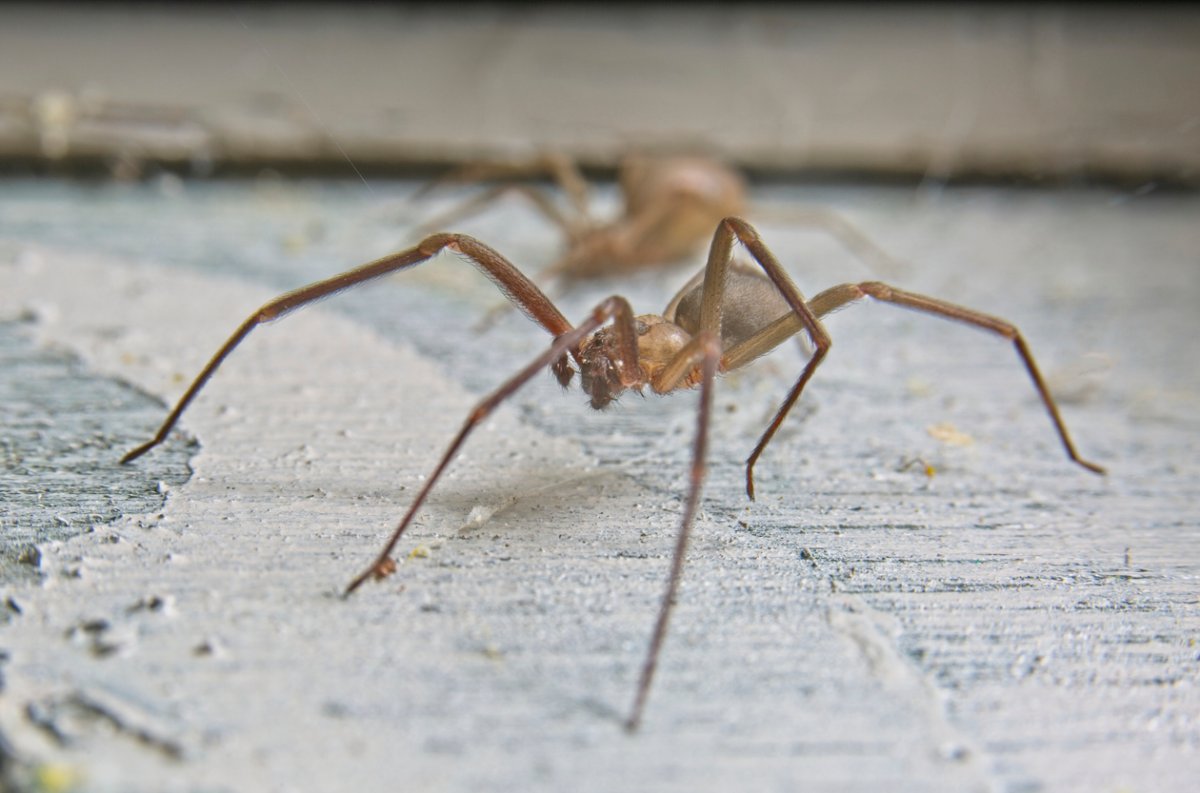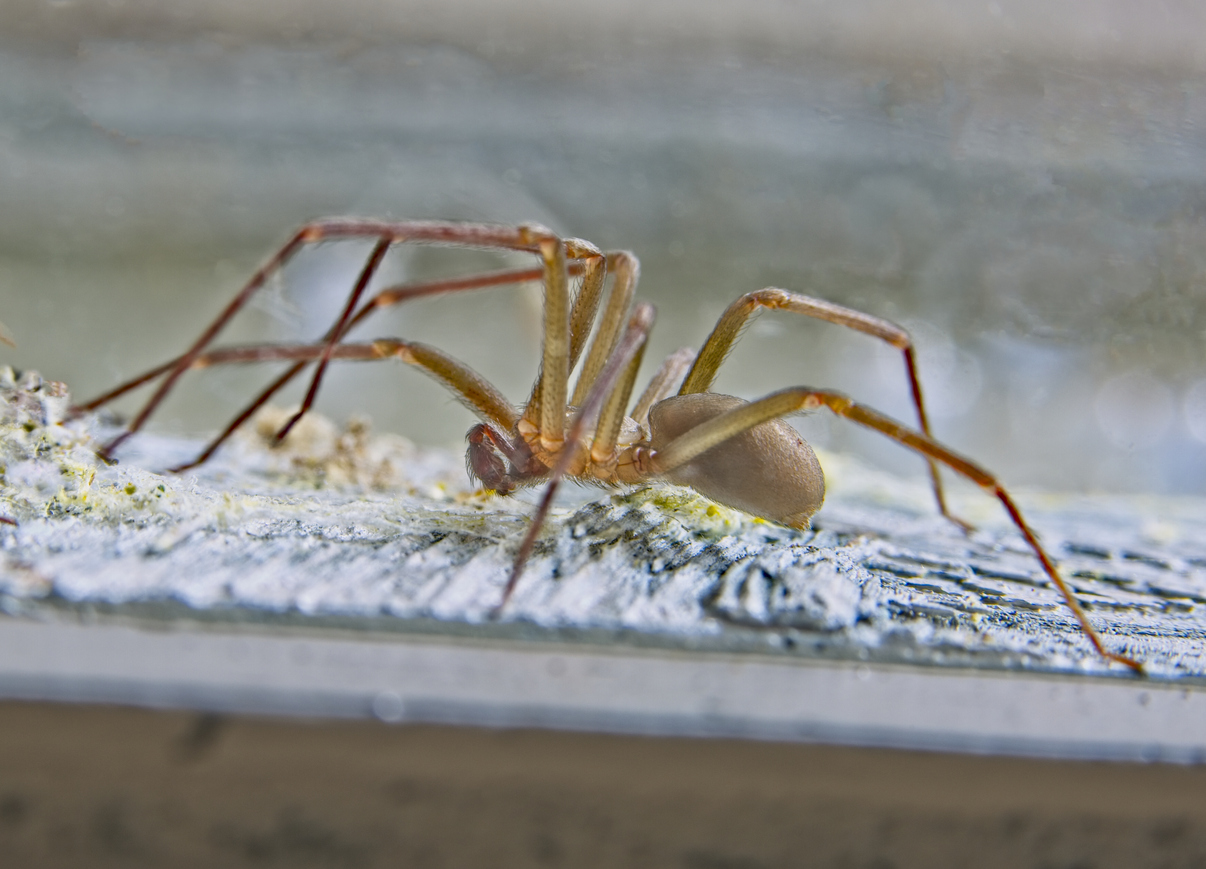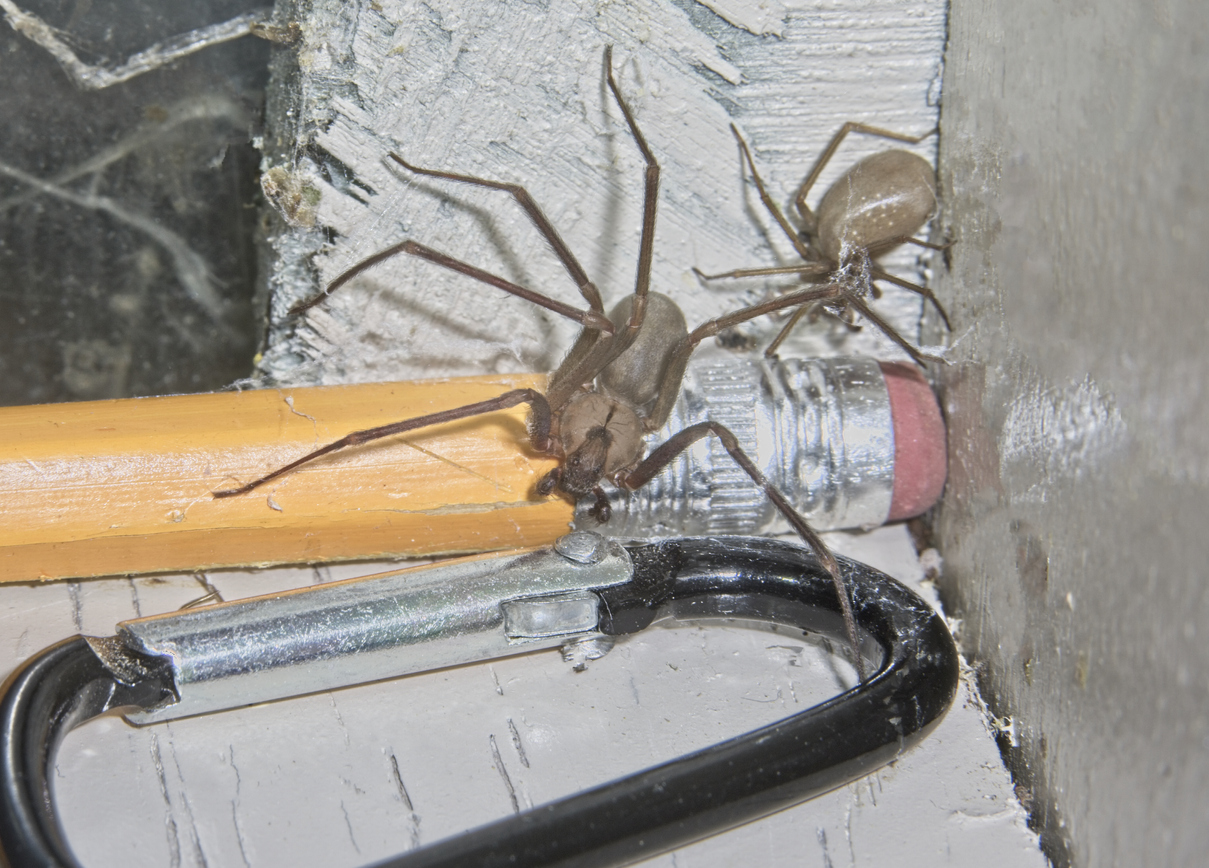

We may earn revenue from the products available on this page and participate in affiliate programs. Learn More ›
The brown recluse spider has a bad reputation for a reason: It has a venomous bite that can cause symptoms such as fever, vomiting, and dizziness. In the event that they take up residence in a home, knowing how to get rid of brown recluse spiders will make a space safer. The good news is that minor spider problems can often be tackled with natural insecticides, repellents, or pesticides. A pest control professional can also survey the space, apply the appropriate treatment, and eliminate any risk of a brown recluse bite. Below, we’ll dive into more detail about brown recluse spiders and what treatment will work best for individual situations.
What are brown recluse spiders, and are they dangerous?
Brown recluse spiders are brown in color with a violin-shaped mark on their backs. Adult brown recluse spiders are about the size of a quarter and are mostly found in the south-central and lower Midwest. Although this species of spider isn’t aggressive, a bite from one can cause dizziness, fever, and vomiting.
Spotting one brown recluse spider may not indicate a problem. But if there are multiple brown recluse spiders in the house or recurring sightings, the resident will likely need to contact an exterminator to eliminate them before the space becomes infested.

Tips for How to Get Rid of Brown Recluse Spiders
- Lay down sticky traps in attics, basements, closets, and garages.
- Apply a spray, liquid, or dust insecticide to cracks and crevices where the spiders are likely to hide.
- Call a pest control company to treat the home.
Safety Considerations
- According to the Occupational Safety and Health Administration, it’s wise to wear protective clothing such as a long-sleeved shirt, hat, boots, and gloves when handling items that may be infested with brown recluse spiders.
- Apply an insect repellent containing DEET on clothing before working in an area with brown recluse spiders.
Tools & Materials
Bobvila.com may earn a commission from purchases made through these links.
- Insect repellent containing DEET
- Caulk
- Eucalyptus plants
- Lavender, peppermint, or tea tree essential oils
- Diatomaceous earth
- Vinegar
- Dish soap
- Spider killer
Time required: 1 to 2 hours
Difficulty: Beginner
Estimated cost: $20 to $300
STEP 1: Identify the spiders and where they are in the house.
Once a resident learns the characteristics or has seen pictures of brown recluse spiders, they can better identify which type of spiders are in the home and where they tend to hide. Since this species only spins webs to hold their egg sacs, it’s unlikely to find evidence of a web. If there is a spider infestation, it’s more common to spot them at night since the spiders typically stay hidden throughout the day. Brown recluse spiders can often be found in cardboard boxes, furniture, inside walls, or in woodpiles. Once it’s been determined where the spiders are, it will be easier to apply treatments in order to eradicate them.

STEP 2: Make the home less inviting to spiders.
One way to get rid of brown recluse spiders is to make the home less appealing to them. This goes for both the outside and the inside of the house, from sealing cracks to eliminate entry points to trimming back brush and removing traces of dust from the interior.
Outside the Home
Since brown recluse spiders like to inhabit woodpiles and plants, it’s best to move these features as far away from the home as possible. These elements should be kept at least a few feet away from the foundation to ensure the arachnids stay at bay.
In the Basement or Crawl Space
Any underground space is likely to attract spiders, which is why it’s necessary to seal any cracks with caulk around doors and window frames. Any current webs can be swept away, woodpiles moved away from doors, and door sweeps installed.
In the Attic
Attics are often dark, dusty areas that are littered with clutter, which is what attracts spiders like brown recluses. This is why it’s wise to regularly clean out the attic by eliminating clutter, getting rid of dust, and vacuuming any current spiderwebs. It’s also a good idea to sweep around boxes and check for any prominent cracks or crevices that need to be sealed.
In the Garage
Because brown recluse spiders like to set up retreats in cardboard boxes, it’s best to break down any empty shipping boxes or other recyclable materials that may seem inviting to the spiders. Any cracks that lead to the inside of the home can be sealed, clutter that can easily hide a brown recluse web can be removed, and repellent can be applied in areas where spiders roam.
STEP 3: Try home remedies to repel spiders.
When dealing with a spider infestation, a resident may wonder, “Why are there so many spiders in my house?” And the answer may be that there hasn’t been enough of an effort to repel spiders. The less inviting a home is to spiders, the less likely they are to find their way inside and stay awhile. One effective way to keep spiders at bay is to use the power of strong scents from plants or essential oils that spiders are known to dislike.

Eucalyptus Plants
As a species, spiders are not fond of strong scents, which is why a potted eucalyptus plant on a windowsill or other area inside the home can help deter brown recluses from coming in. The one downside to eucalyptus plants is that they often grow too big to stay inside and will need to be replanted outdoors to survive. They also require plenty of sunlight, so if the space doesn’t receive a lot of direct sun, another natural repellent may be required.
Essential Oils
Lavender, peppermint, and tea tree are three essential oils with strong odors that are likely to repel insects and arachnids such as the brown recluse. It’s easy to make a solution of water and one of these oils to spray around the home, or the oils can be diffused. If making a concentrated solution in a spray bottle, it’s best to apply it to entry and exit points in the home, as well as anywhere a brown recluse spider has been spotted.
STEP 4: Opt for natural methods to kill brown recluse spiders.
Once the home is inhospitable to any future brown recluses, it’s time to eradicate any that may still be in the home. Many residents are interested in how to get rid of brown recluse spiders naturally to avoid exposing themselves, young children, or animals to harmful chemicals. From traps to natural solutions and concoctions made of common household ingredients, it’s completely possible to treat a brown recluse infestation with methods that don’t pose a risk to the household.

Sticky Traps
If a resident is wary of using any kind of chemicals inside the home, sticky traps may be the best way to get rid of brown recluse spiders. These traps use a glue surface with a molasses and nonallergenic peanut scent that attracts spiders and traps them inside. The traps can be folded horizontally or made flat to adhere under shelves or on walls.
Diatomaceous Earth
This natural insecticide powder is made of fossilized remains of microscopic aquatic organisms and works by getting inside spiders’ exoskeletons and dehydrating them. Diatomaceous earth usually kills spiders within 48 hours and is not harmful to humans, pets, or other animals.
Vinegar
A mixture of white vinegar, water, and dish soap can also do the trick, if a resident prefers to use ingredients they likely already have at home. These three elements can be mixed together in a spray bottle, then applied around windows, doors, or other areas where a brown recluse spider is likely to show up.
STEP 5: Kill brown recluse spiders with insecticides.
Insecticides are often a sure-fire way to kill brown recluse spiders. Depending on how pervasive the problem is, the best spider killers on the market can often be purchased online or at the local hardware store. Although this is not a natural or harmless way of getting rid of brown recluse spiders, it’s a more effective method for those looking for a quick way to remove them from the space. Insecticides with the ingredients pyrethrin and deltamethrin will do the job on the spot, but they are also harmful to aquatic organisms and pollinators like bees, so users will want to consider this if they’re applying the treatment outside.

STEP 6: Call an exterminator for professional help.
For those who have tried all of the DIY methods and are still spotting these pesky spiders in the home, it may be time to call a professional. Or for those who’d like to skip any attempt at eliminating the bugs themselves and would prefer to get an expert on the job, an exterminator is the right person to call. The best pest control companies like Orkin and Terminix have extensive experience and knowledge to lean on, so they can not only confirm that the arachnid present is a brown recluse, but they can also determine where they’re hiding out and how to treat them to get rid of them quickly. They’ll also be able to identify ways to prevent the spiders from coming back into the home.
When a resident needs to know how to get rid of spiders, especially brown recluses, the above steps can help treat a wide range of problems, from one or two stray insects to an uncontrollable infestation. But before attempting to DIY this project, it’s wise to figure out which method is best while keeping the household’s safety a top priority. In some instances, it may be best to skip the DIY route and seek the help of a professional who can get it right the first time.
FAQs
For those who want to know more about the brown recluse spider, here are answers to some of the most common questions about this arachnid.
A brown recluse spider is a grayish yellow-brown with a violin-shaped mark on its back. Females are bigger than males, with adult female spiders growing to about the size of a quarter. In general, these spiders range from ¼ to ½ inch long.
Wolf spiders are one of the few spiders that look like the brown recluse. Wolf spiders are larger than brown recluse spiders and have hairier legs. Brown recluses are usually ¼ to ½ inch long, while a wolf spider is bigger than ½ inch. Wolf spiders have venom and fangs, but their bites are typically not harmful to humans or pets.
In the beginning, the bite mark might be red with the evidence of punctures from fangs. A few hours later, the bite may resemble more of a bullseye with a red ring around the puncture site.
If you get bitten by a brown recluse spider, it’s best to apply ice to the area, elevate it, and keep it as still as possible. You should also seek medical attention, as symptoms can lead to sickness that might be preventable.
Yes, exterminators can get rid of brown recluse spiders.
No, this type of spider does not jump.
As their name suggests, brown recluses like to build retreats in hidden, tucked-away areas, often on wooden surfaces. This means they usually set up camp in furniture, cardboard boxes, inside walls, and in the wood framing of dark areas such as basements and attics.
If you spot one of these venomous spiders in your home, it’s best to call a pest control professional to remove any trace of them. If an exterminator can’t immediately apply treatment, you can try DIY methods such as sticky traps and insect repellent while you wait.
Although a bite from a brown recluse can lead to scary symptoms such as fever, vomiting, and dizziness, it is rare for their venom to kill people.
You are most likely to see brown recluses from March to October.
The diet of brown recluses consists of cockroaches, crickets, and other soft-bodied insects, though it’s not uncommon for them to go months without eating.
Yes, although they do not use their webs to trap prey, like other species of spiders. Instead, they use webs as a retreat as well as to hold their eggs. Their webs are more loosely constructed with irregular patterns and are often found in dark areas like attics, basements, closets, and crawl spaces.
Sources: Kapture Pest Control
